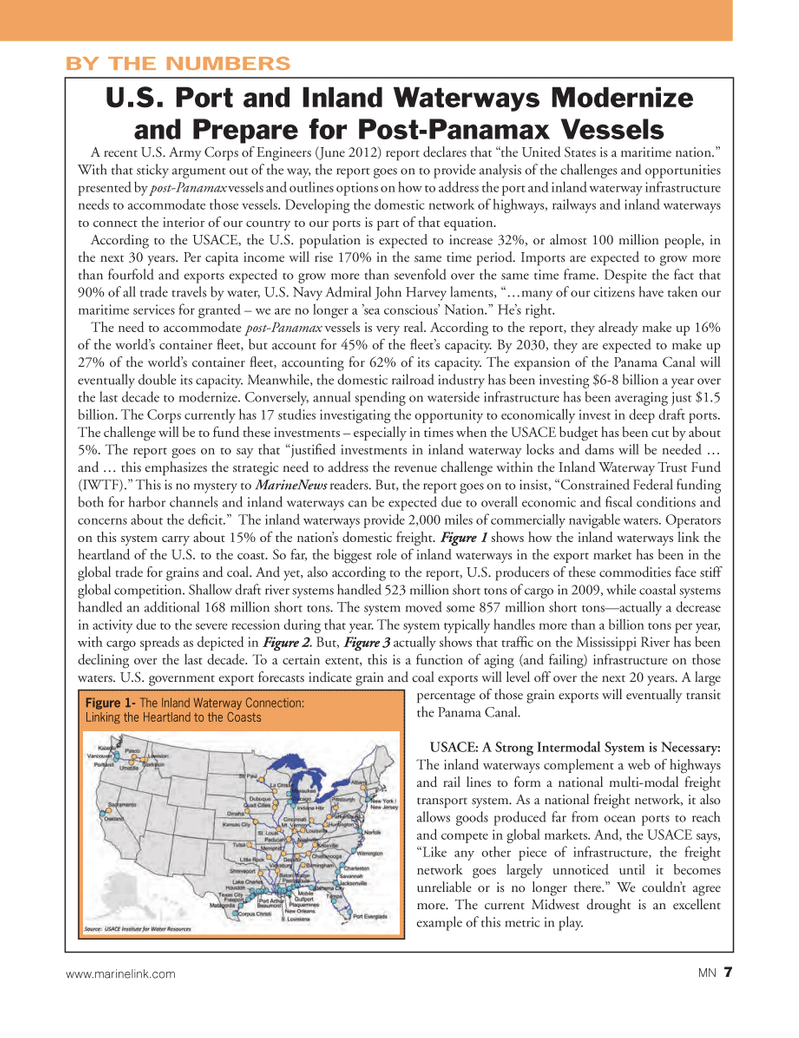
Page 7: of Marine News Magazine (August 2012)
Salvage & Recovery
Read this page in Pdf, Flash or Html5 edition of August 2012 Marine News Magazine
A recent U.S. Army Corps of Engineers (June 2012) report declares that ?the United States is a maritime nation.? With that sticky argument out of the way, the report goes on to provide analysis of the challenges and opportunities presented by post-Panamax vessels and outlines options on how to address the port and inland waterway infrastructure needs to accommodate those vessels. Developing the domestic network of highways, railways and inland waterways to connect the interior of our country to our ports is part of that equation. According to the USACE, the U.S. population is expected to increase 32%, or almost 100 million people, in the next 30 years. Per capita income will rise 170% in the same time period. Imports are expected to grow more than fourfold and exports expected to grow more than sevenfold over the same time frame. Despite the fact that 90% of all trade travels by water, U.S. Navy Admiral John Harvey laments, ??many of our citizens have taken our maritime services for granted ? we are no longer a ?sea conscious? Nation.? He?s right. The need to accommodate post-Panamax vessels is very real. According to the report, they already make up 16% of the world?s container eet, but account for 45% of the eet?s capacity. By 2030, they are expected to make up 27% of the world?s container eet, accounting for 62% of its capacity. The expansion of the Panama Canal will eventually double its capacity. Meanwhile, the domestic railroad industry has been investing $6-8 billion a year over the last decade to modernize. Conversely, annual spending on waterside infrastructure has been averaging just $1.5 billion. The Corps currently has 17 studies investigating the opportunity to economically invest in deep draft ports. The challenge will be to fund these investments ? especially in times when the USACE budget has been cut by about 5%. The report goes on to say that ?justi ed investments in inland waterway locks and dams will be needed ? and ? this emphasizes the strategic need to address the revenue challenge within the Inland Waterway Trust Fund (IWTF).? This is no mystery to MarineNews readers. But, the report goes on to insist, ?Constrained Federal funding both for harbor channels and inland waterways can be expected due to overall economic and scal conditions and concerns about the de cit.? The inland waterways provide 2,000 miles of commercially navigable waters. Operators on this system carry about 15% of the nation?s domestic freight. Figure 1 Figure 1 shows how the inland waterways link the heartland of the U.S. to the coast. So far, the biggest role of inland waterways in the export market has been in the global trade for grains and coal. And yet, also according to the report, U.S. producers of these commodities face stiff global competition. Shallow draft river systems handled 523 million short tons of cargo in 2009, while coastal systems handled an additional 168 million short tons. The system moved some 857 million short tons?actually a decrease in activity due to the severe recession during that year. The system typically handles more than a billion tons per year, with cargo spreads as depicted in Figure 2 Figure 2. But, Figure 3 Figure 3 actually shows that traf c on the Mississippi River has been declining over the last decade. To a certain extent, this is a function of aging (and failing) infrastructure on those waters. U.S. government export forecasts indicate grain and coal exports will level off over the next 20 years. A large percentage of those grain exports will eventually transit the Panama Canal. USACE: A Strong Intermodal System is Necessary: The inland waterways complement a web of highways and rail lines to form a national multi-modal freight transport system. As a national freight network, it also allows goods produced far from ocean ports to reach and compete in global markets. And, the USACE says, ?Like any other piece of infrastructure, the freight network goes largely unnoticed until it becomes unreliable or is no longer there.? We couldn?t agree more. The current Midwest drought is an excellent example of this metric in play. BY THE NUMBERSU.S. Port and Inland Waterways Modernize and Prepare for Post-Panamax Vessels Figure 1- The Inland Waterway Connection: Linking the Heartland to the Coasts MN 7www.marinelink.com

 6
6

 8
8
